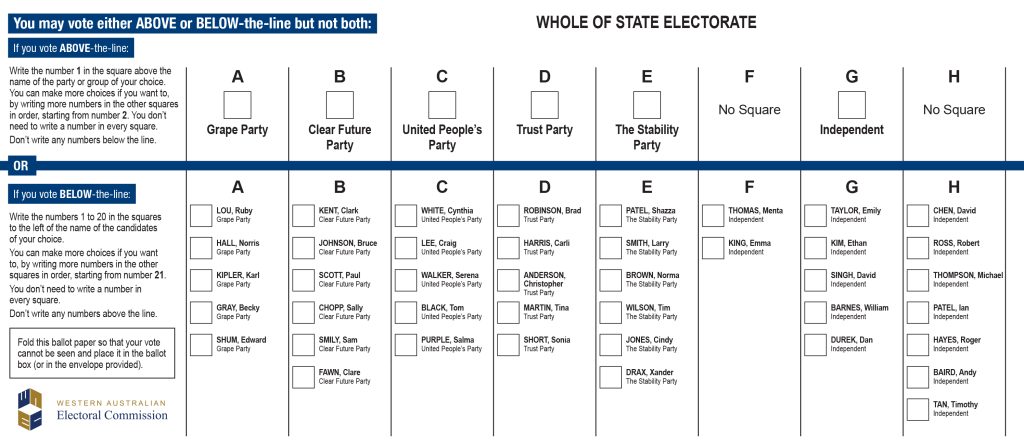2.6 Chapter Summary
Real Life Example: Western Australia
Below is a sample ballot for Legislative Council elections in the state of Western Australia. Review the ballot (click to enlarge the image) and use the checklist below to see if it follows the recommended best practices for ballot design.

Image Description
This is a sample ballot paper from the Western Australian Electoral Commission for a whole-of-state electorate. Voters are instructed that they may vote either above the line or below the line, but not both.
Above-the-line voting: Voters write the number 1 in one of the boxes above the party columns (A to E), and can continue with numbers in other boxes in order of preference.
Below-the-line voting: Voters number individual candidates in the boxes to the left of their names from 1 to 20, and may continue numbering further if they choose.
There are eight columns labelled A through H, with columns A to E containing party names and logos (Grape Party, Clear Future Party, United People’s Party, Trust Party, The Stability Party) and a blank box above each. Columns F and H have no box above the line, and columns F to H contain only independent candidates.
Each column lists multiple candidates with square checkboxes next to their names. For example:
Column A (Grape Party) lists six candidates, including LOU, Ruby and SHUM, and Edward.
Column G (Independent) includes TAYLOR, Emily and DUREK, Dan.
Column H (Independent) includes CHEN, David and TAN, Timothy.
Instructions emphasize not mixing above-the-line and below-the-line voting, and to fold the ballot paper before placing it in the ballot box.
Checklist questions:
- The font is readable and consistent.
- Text is left-aligned and written in sentence case
- Formatting and shading are used to highlight important information.
- The spacing between candidates is equal
- Marking spaces are simple and consistent (i.e. all squares or all circles)
- The contests are clearly delineated.
- Instructions are placed where voters can see them
- Instructions are complete with all relevant information
- Instructions are written in simple language that voters can understand.
- Icons or images are used to enhance clarity.

What do you think?
- Is it an effective ballot design?
- Are there any improvements you would recommend?
Further Reading & Resources
If you’d like to learn more about this topic, check out the following article:
- Disenfranchised by Design from ProPublica.
Chapter Summary
- Ballots, the tools for casting votes, have evolved from public voice voting (viva voce) to private paper ballots due to issues like bribery, violence, and limited scalability.
- The Australian Ballot introduced uniform, government-printed ballots with secret voting, greatly reducing intimidation but introducing challenges for voters with limited literacy.
- Ballot design impacts accessibility and outcomes; features like candidate order, ballot layout, and how choices are marked (single, ranked, or negative) can all influence voter behaviour.
- Complex ballots, such as those used in the U.S., may include multiple races and instructions, increasing the risk of overvotes, undervotes, and spoiled ballots due to voter confusion.
- Poor ballot design can lead to election-affecting errors; notable examples include the 2000 Florida “butterfly ballot” and the 2018 Florida Senate undervote caused by confusing layouts.
- Language and literacy barriers can prevent voter participation; some countries use visual aids like colors, logos, and photos, or ballots in multiple languages to improve accessibility.
- Best practices for ballot simplicity and accessibility include using left-aligned sentence case text, clear formatting, consistent spacing, and accessible versions for voters with disabilities.
- Ballot design is not just about user experience—it can significantly impact democratic participation and electoral outcomes by either supporting or obstructing voter understanding.
OpenAI. (2025, May 27). ChatGPT. [Large language model]. https://www.chatgpt.com Prompt: Can you please summarize the passage into 8 key points with no additional bullets. Edited & Reviewed by author.
Key Terms
Australian Ballot – A government-printed, standardized ballot that lists all candidates and is marked by voters in secret. Introduced in Australia in the 19th century, it reduced vote-buying and intimidation and is now standard in many democracies.
Butterfly Ballot – A ballot design with choices on both sides of a central column, which can confuse voters. The term became widely known after the 2000 U.S. election in Palm Beach County, Florida, where its confusing layout led to many misvotes.
Mark Choice – A mark choice ballot is the most common method for indicating a preference. Voters will typically place a mark or other indication beside the candidate they prefer. This could also involve punching a hole through paper, selecting an option on a touchscreen interface, or writing a candidate’s name into a blank space.
Negative Choice – In a negative choice format, voters are asked to cross out the candidates they don’t want. These ballots can be more error-prone and difficult to count.
Overvote – Occurs when a voter selects more options than allowed in a particular race or contest, rendering that part of the ballot invalid.
Rank Choice – A voting method where voters rank candidates in order of preference. If no candidate receives a majority, the candidate with the fewest votes is eliminated and their votes are redistributed based on second preferences, continuing until a majority is reached.
Spoiled Ballot – A ballot that has been deliberately marked incorrectly or defaced, often as a form of protest. It is not counted in the election results.
Ticket – a ballot created by newspapers or political parties for their preferred candidates.
Treating – a name given to offering food, drink, and even cash in exchange for votes.
Undervote – Happens when a voter does not select any option in a given race or contest, either intentionally or by mistake.
Viva voce – A method of voting in which individuals verbally declare their vote in public. Common in early elections, this method was vulnerable to intimidation and corruption.

